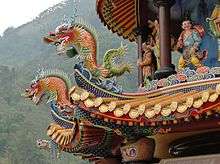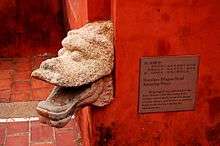Chiwen



Chiwen (Chinese: 螭吻; pinyin: chīwěn; Wade–Giles: ch'ih-wen; literally: "hornless-dragon mouth", Chi Wen) is a chinese dragon, and one of the 9 sons of the dragon in Chinese mythology. He is depicted in imperial roof decorations and other ornamental motifs in traditional Chinese architecture and art.
This Chinese dragon name chiwen 螭吻 compounds chi 螭 "hornless dragon; young dragon" and wen 吻 "(animal's) mouth; lips; kiss". Chishou 螭首 and Chitou 螭頭 (both literally meaning "hornless-dragon head") are related architectural ornaments or waterspouts, comparable with Western gargoyles. Chiwen and Chishou are not the character in chinese mythology.
Chiwen 螭吻 is alternatively written chiwen 鴟吻 ("owl mouth"), using the homophonous Chinese character chi 鴟 "owl; sparrowhawk; bird of prey". The chiwei 鴟尾 ("owl tail") and chimeng 鴟甍 ("owl roof-ridge") are additional birdlike roof decorations.
The chiwen is listed second or third among the Long sheng jiuzi 龍生九子 ("dragon gives birth to nine young"), Nine Dragons (Chinese: 九龙; pinyin: jiǔlóng), which are traditional mythology creatures and become traditional Chinese fengshui architectural decorations. Each one of those creatures have a protective function. The Nine dragon are also used in many place names, such as Kowloon ("nine dragons" in Cantonese), in Hong Kong, but also numerous lakes, rivers or hamlets in mainland China.
According to the Ming Dynasty Wuzazu 五雜俎 (tr. Visser 1913:101), "The ch'i-wen, which like swallowing, are placed on both ends of the ridgepoles of roofs (to swallow all evil influences)."
Welch describes chiwen as "the dragon who likes 'to swallow things'".
This is the fish-like, hornless dragon with a very truncated body and large, wide mouth usually found along roof ridges (as if swallowing the roof beams). His presence on roofs is also said to guard against fires. A paragraph in the Tang dynasty book Su Shi Yan Yi (苏氏演义) by Su E (苏鹗) says that a mythical sea creature called the chi wen [sic] was put on the roofs of buildings during the Han dynasty to protect the structures from fire hazards. This dragon is still found on the roofs of traditional Chinese homes today, protecting the inhabitants from fires. (2008:122-3)
In Fengshui theory, a chiwen or chiwei supposedly protects against not only fire, but also flood and typhoon.
The Japanese language borrowed these names for architectural roof decorations as Sino-Japanese vocabulary. Shibi 鴟尾 "ornamental roof-ridge tile" is more commonly used than chifun 螭吻 or shifun 鴟吻. In Japanese mythology, the Shachihoko 鯱 "a mythical fish with a carp's arched tail, tiger's head, and dragon's scales" roof decoration is believed to cause rain and protect against fire. This 鯱 is a kokuji "Chinese character invented in Japan" that can also be read shachi for "orca".
References
- Visser, Marinus Willern de. 1913. The Dragon in China and Japan. Johannes Müller.
- Welch, Patricia Bjaaland. 2008. Chinese Art. Tuttle, 2008. ISBN 0-8048-3864-X. Partial text available on Google Books. Pages 122-123.
External links
| Wikimedia Commons has media related to Chiwen. |
- The Nine Dragon Scroll, The Circle of the Dragon